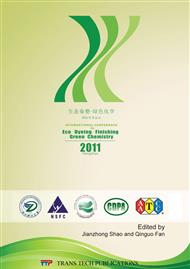p.304
p.309
p.315
p.320
p.326
p.332
p.337
p.342
p.346
Technique and Effect of Wash and Wear Finish on Bast Fabric
Abstract:
The wash and wear finish of bast fabric was reported in this paper. The influence of various factors on wash and wear finish effect was studied by method of orthogonal experimentr. The result indicated that the proper range of concentration of finish was 80-100 g/L with catalyst MgCl2 of 8% relative to dose of finishing agent at curing temperature of 160 °C for 3 mins. The wrinkle recovery angle and breaking elongation percentage could be enhanced by pretreatment with NaOH liquor of 20-25 g/L. The performance of the wash and wear finish could be improved by finish with amino organosilicon. In the process of low formaldehyde wash and wear finish, the concentration of finish was a key parameter, dose of catalyst MgCl2 and curing temperature were main parameters.
Info:
Periodical:
Pages:
326-331
Citation:
Online since:
January 2012
Authors:
Keywords:
Price:
Сopyright:
© 2012 Trans Tech Publications Ltd. All Rights Reserved
Share:
Citation:


